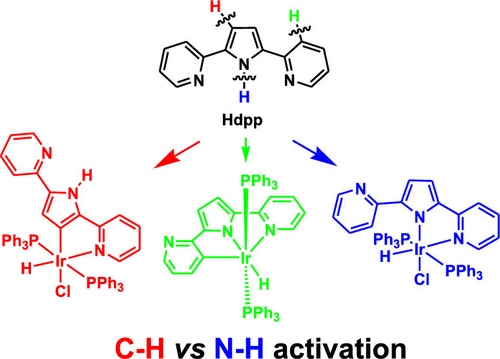Formation of Iridium(III) Complexes via Selective Activation of the C–H and N–H Bonds of a Dipyridylpyrrole Ligand

Treatment of [Ir(PPh3)3Cl] with 2-[5-(pyridin-2-yl)-1H-pyrrol-2-yl]pyridine (Hdpp) in refluxing toluene affords an unexpected pyrrole-metalated iridium(III) hydride complex, [Ir(K2C,N-dpp)(H)(Cl)(PPh3)2] (1), via Cpyrrole–H activation, while the presence of the base KOtBu as the deprotonation reagent produces a pyridine-metalated iridium(III) hydride complex, [Ir(K3C,N,N-dpp)(H)(PPh3)2] (2), via Cpyridine–H activation. Treatment of [Ir(PPh3)3Cl] prepared by a convenient method with Hdpp in the presence of KOtBu under the refluxing mixture solvent toluene/methanol (2:1, v/v) generates the N,N-chelating complex [Ir(K2N,N-dpp)(H)(Cl)(PPh3)2] (3) together with 1 and the N,N-chelating dihydride complex [Ir(K2N,N-dpp)(H)2(PPh3)2] (4). Complex 4 is also readily produced by the reaction of [Ir(PPh3)3Cl] and Hdpp in the presence of KOtBu under refluxing methanol or by the reaction of IrCl3 and PPh3 in refluxing 2-ethoxyethanol. Complexes 1–4 are fully characterized by NMR, IR, and UV–vis spectroscopy and X-ray diffraction analysis. The dpp–/dpp2– ligand shows rich coordination capability, of which pyridine- and pyrrole-cyclometalated coordination modes are first reported. The formation of structural isomers 1 and 3 involved the selective activation of the C–H and N–H bonds of Hdpp is rationalized by theoretical calculations.
